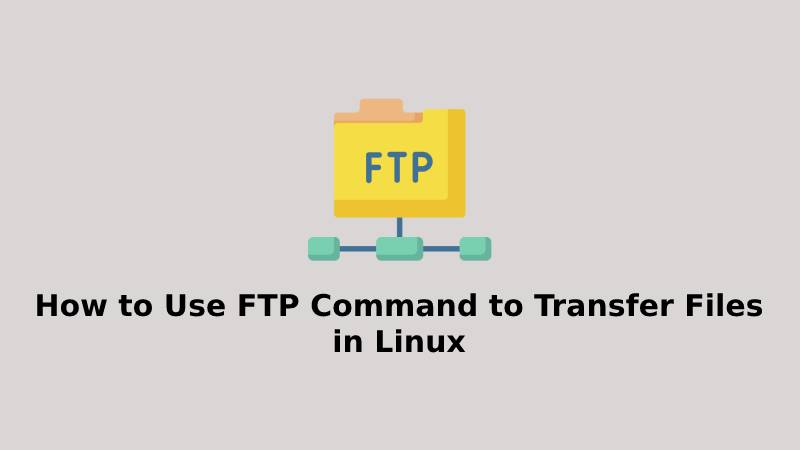FTP or File Transfer Protocol is a standard network protocol used to transfer files between servers and clients. FTP is widely used for uploading, downloading, and managing files on remote servers. In this article, we will explore how to use the Linux FTP command to transfer files between local and remote servers.
Important Notes Before You Begin
FTP Traffic is Not Encrypted
FTP traffic is not encrypted, which means that any data transferred using FTP can be intercepted and read by anyone who has access to the network. For a secure data transfer, it is recommended to use SCP or SFTP instead.
Permissions Required for File Transfer
To transfer files, you must have at least read permissions on the source file and write permission on the target system. Make sure that you have the appropriate permissions to read the source file and write to the target system.
Considerations for Large File Transfer
When transferring large files, it is recommended to run the ftp command inside a screen or tmux session. This will allow you to resume the transfer in case of a network disruption or if the FTP client is disconnected.
Local Working Directory
The directory from where you run the ftp command is the local working directory. This means that any files you want to transfer must be located in this directory or its subdirectories. Make sure that the source file is located in the local working directory or specify the full path to the file when transferring it.
Establishing an FTP Connection to a Remote Server
To connect to a remote server, you need to use the FTP command followed by the IP address or hostname of the remote server. For example, to connect to a server with IP address 192.168.0.100, you would use the following command:
$ ftp 192.168.0.100Replace 192.168.0.100 with the IP address or domain name of the remote server you want to connect to. After you enter this command, you will see the following output:
Connected to 192.168.0.100.
220 (vsFTPd 3.0.3)
Name (192.168.0.100:username): This output indicates that you have successfully connected to the remote server, and it is running vsFTPd version 3.0.3. You are now prompted to enter your username.
Enter your username and press Enter. You will be prompted to enter your password:
Name (192.168.0.100:username): username
331 Please specify the password.
Password:Enter your password and press Enter. If the credentials are correct, you will see the following output:
230 Login successful.
Remote system type is UNIX.
Using binary mode to transfer files.
ftp> This output indicates that you have successfully logged in to the remote server, and you are now ready to transfer files using FTP. You can now enter FTP commands to navigate the remote server, upload or download files, and exit the FTP client when you’re done.
Once you are connected to the remote server, you can navigate through the directories by using the following commands:
$ pwd # to display the current working directory
$ cd directory_name # to change to a specific directory
$ ls # to list the contents of the current directoryHow to Transfer File Using FTP Command
To transfer files between the local and remote servers, you need to use the following commands:
$ put local_file remote_file # to upload a local file to the remote server
$ get remote_file local_file # to download a remote file to the local computerUpload a Local File to Remote Server
To upload a local file named “file.txt” to the remote server, you would use the following command:
$ put file.txt /remote/directory/file.txtThis command will upload the file to the remote server in the specified directory.
Download a Remote File to the Local Computer
To download a remote file named “file.txt” to the local computer, you would use the following command:
$ get /remote/directory/file.txt file.txtThis command will download the file from the remote server to the current directory on the local computer.
How to Transfer Multiple Files Using FTP Command
Transferring multiple files using FTP is a common task that can save a lot of time and effort. You can use the mget and mput commands in FTP to transfer multiple files at once.
Download Multiple Remote Files to the Local Computer
To download multiple files from the remote server to your local machine, use the mget command followed by the list of filenames you want to download. For example:
ftp> mget file1.txt file2.txt file3.txtThis command will download the files file1.txt, file2.txt, and file3.txt from the remote server to your local machine. You can also use wildcard characters to download multiple files that match a certain pattern. For example:
ftp> mget *.txtThis command will download all files with the .txt extension from the remote server to your local machine.
Upload Multiple Local Files to Remote Server
To upload multiple files from your local machine to the remote server, use the mput command followed by the list of filenames you want to upload. For example:
ftp> mput file1.txt file2.txt file3.txtThis command will upload the files file1.txt, file2.txt, and file3.txt from your local machine to the remote server. You can also use wildcard characters to upload multiple files that match a certain pattern. For example:
ftp> mput *.txtThis command will upload all files with the .txt extension from your local machine to the remote server.
When using the mget and mput commands to transfer multiple files, you will be prompted to confirm each file transfer. If you want to transfer all files without being prompted for confirmation, use the -i option with the mget or mput command. For example:
ftp> mget -i *.txtThis command will download all files with the .txt extension from the remote server to your local machine without prompting for confirmation. Similarly, you can use the -i option with the mput command to upload multiple files without being prompted for confirmation.
Closing the FTP Connection
Once you have finished transferring files, you can close the FTP connection by using the following command:
$ byeThis command will terminate the FTP session and return you to the command prompt on your local computer.
Most Common FTP Commands
Here are some of the most commonly used FTP commands that you can use to navigate the remote server, upload or download files, and manage your FTP session:
- open: This command is used to connect to a remote FTP server.
- user: This command is used to specify the username for the FTP session.
- pass: This command is used to specify the password for the FTP session.
- cd: This command is used to change the current working directory on the remote server.
- lcd: This command is used to change the local working directory on your local machine.
- ls: This command is used to list the files and directories in the current remote directory.
- dir: This command is used to display a detailed list of files and directories in the current remote directory.
- get: This command is used to download a file from the remote server to your local machine.
- mget: This command is used to download multiple files from the remote server to your local machine.
- put: This command is used to upload a file from your local machine to the remote server.
- mput: This command is used to upload multiple files from your local machine to the remote server.
- quit: This command is used to exit the FTP session.
- bye: This command is also used to exit the FTP session.
- help: This command is used to display a list of available FTP commands or get help for a specific command
These are just a few examples of the most commonly used FTP commands. There are many more commands available, and you can find a full list of FTP commands by typing help in the FTP client prompt.
Conclusion
In this article, we have explored how to use the Linux FTP command to transfer files between local and remote servers. With the FTP command, you can easily upload, download, and manage files on remote servers. By following the steps outlined in this tutorial, you can easily connect to a remote server, navigate through directories, and transfer files using the FTP command.
Got questions or suggestions on the article? Don’t hesitate to leave a comment below. Your feedback is valuable to us and helps improve the content quality. And don’t forget to share this article with others who might find it useful. Looking forward to hearing from you!
If our tutorials helped you, please consider buying us a coffee. We appreciate your support!
Thank you for your support.


